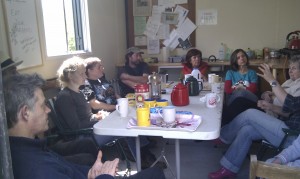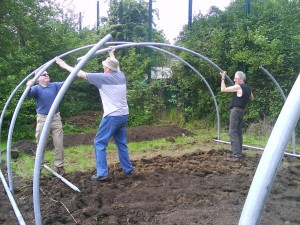Once a potential site has been identified there are many factors to consider in assessing its suitability as a potential community garden. Who owns the land, is it accessible and safe to all members of the community? What’s the history of the site? Is it possible that the land may be contaminated? These are all questions that need to be asked and discussed before progressing with any plans.
Luckily our first site was situated on an organic farm and as a result we didn’t have many of these considerations. The main issue for us in terms of site preparation was that the site chosen, at the corner of a field turned out be very, very wet although drainage had been put in place. After a number of weeks of digging in wet soil we took the decision to move the main growing area to a higher location. Unfortunately we already had our polytunnel up and that had to remain in place. We solved the problem there by digging round it, creating additional drains and making raised beds in the polytunnel.
In an urban plot, whether at the edge of a City Council park, on waste ground or on municipal land there are many considerations. Once the suitability of the site has been established and permission in principle to use the land has been granted, a soil test has to be undertaken in order to establish that there are no poisonous substances in the soil.
The key facilities that an accessible community garden will need are;
- Access to water – Do not underestimate how long or the cost of get running water onto a site. In the waterworks it took over a year to have a tap put onto the site. The first year of the garden was an exceptionally dry year and if it weren’t for the good will of neighbouring houses, who let us run a hose from their back garden once a week, the garden would have failed.
- A large polytunnel – Grow recruits between 12-14 participants into each group, so the polytunnel needs to be large enough to accommodate this group. As part of our model of sustainable development we like to propagate as many of our plants as possible, so the polytunnel is used to bring plants on as well as growing fruit and vegetables that need to grown inside.
- A meeting area – When the weather is good, if we need to discuss any aspect of the garden, community activites or plan for some of our events we will set up outside and have our meeting there. However you need to plan for all weathers. Putting an anti-vandal unit on site which doubles as a safe storage space for tools at one end and a meeting space at the other end has proved a good solution. Some community gardens are located adjacent to a community centre where there is an agreement in place for use of the centre’s facilities.
- Raised beds and accessible paths – For those with limited mobility it is essential that you consider putting in place some beds that are raised in order to minimise bending down and that are accessible to wheelchairs. You also need to think about the width and materials used for your paths around the garden.
- Toilet – Unfortunately we do not have a toilet on our Waterworks site and this has been one of the main complaints that participants have had in relation to the garden.
- Site security – while it would be the wish of Grow that our community gardens are open to the public at all times, we have taken a pragmatic approach to this. Until the garden is well established we believe that the site must be secure against potential vandalism, dog fowling and littering. At present we aim have the garden open three days per week. Our intention as we progress is to open the garden as much as possible in order to share both the beautiful space the community gardeners have created and our gardening and community experience.
Keep it Simple
One last word on the garden design and site preparation – keep it simple – you don’t need an elaborate design to grow fruit and veg and a place to meet to discuss community issues. Choose the sunniest place for your growing beds, place your polytunnel away from the fence so that it cannot be easily damaged and place your meeting space at the north end of the garden so that it doesn’t shade or take away from any of the growing space.
And PLEASE done put in lots of unnecessary hard standing!







- Facebook.com/growcommunitygarden
- info@grow-ni.org
- Twitter @growcommunityni
Donate